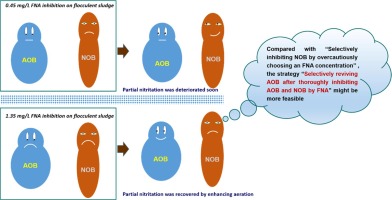当前位置:
X-MOL 学术
›
Environ. Int.
›
论文详情
Our official English website, www.x-mol.net, welcomes your
feedback! (Note: you will need to create a separate account there.)
Recovering partial nitritation in a PN/A system during mainstream wastewater treatment by reviving AOB activity after thoroughly inhibiting AOB and NOB with free nitrous acid.
Environment International ( IF 10.3 ) Pub Date : 2020-04-01 , DOI: 10.1016/j.envint.2020.105684 Bo Wang 1 , Zenghua Wang 2 , Shanyun Wang 3 , Xin Qiao 1 , Xiaofei Gong 1 , Qingteng Gong 1 , Xuefan Liu 1 , Yongzhen Peng 1
Environment International ( IF 10.3 ) Pub Date : 2020-04-01 , DOI: 10.1016/j.envint.2020.105684 Bo Wang 1 , Zenghua Wang 2 , Shanyun Wang 3 , Xin Qiao 1 , Xiaofei Gong 1 , Qingteng Gong 1 , Xuefan Liu 1 , Yongzhen Peng 1
Affiliation

|
Starting up or recovering partial nitritation is a major challenge for achieving or maintaining stable partial nitritation/anammox (PN/A) during mainstream wastewater treatment. This study presents a novel strategy for recovering the nitrite pathway by selectively reviving ammonium oxidizing bacteria (AOB) after thoroughly inhibiting AOB and nitrite oxidizing bacteria (NOB) using free nitrous acid (FNA). A sequencing batch reactor was operated for PN/A to treat real domestic wastewater for 423 days, during which twice FNA treatment was temporarily implemented. Results showed that with a single 0.45 mg/L FNA treatment on flocculent sludge, the NO3--N concentration during the aerobic period showed an uptrend again and the partial nitritation performance was deteriorated. In contrast, 1.35 mg/L FNA treatment induced the inhibition of both AOB and NOB leading to regressive ammonium oxidation, but a subsequently higher DO (1.5 mg/L) and longer aeration duration recovered partial nitritation. For the relative abundances of the acquired biomass related to nitrogen conversion, Nitrosomonas, Nitrospira and Nitrolancea increased to 9.65%, 10.27% and 4.35%, respectively, at the beginning of the 1.35 mg/L FNA treatment, and Nitrospira and Nitrolancea decreased to 2.80% and 0.03% whereas Nitrosomonas declined to 8.71% after 76 days. Ca. Brocadia showed less resilience after the 1.35 mg/L FNA treatment, with the relative abundance decreasing from 13.38% to 0.62% due to insufficient nitrite. Molecular ecological network analysis indicates that among anammox taxa, Ca. Kuenenia and Ca. Brocadia formed important links with other N cycle processes. Moreover, the proposed strategy shows operational flexibility because it can be easily used to control NOB in mainstream PN/A applications offered by flocculent sludge systems.
中文翻译:

通过用游离亚硝酸彻底抑制AOB和NOB后恢复AOB活性,从而在主流废水处理过程中恢复PN / A系统中的部分硝化作用。
在主流废水处理过程中,启动或恢复部分硝化是实现或维持稳定的部分硝化/厌氧氨氮(PN / A)的主要挑战。这项研究提出了一种新的策略,可通过使用游离亚硝酸(FNA)完全抑制AOB和亚硝酸盐氧化细菌(NOB)后选择性地复活铵氧化细菌(AOB)来恢复亚硝酸盐途径。操作了用于PN / A的顺序批处理反应器来处理实际生活废水423天,在此期间暂时实施了两次FNA处理。结果表明,仅用絮凝污泥进行0.45 mg / L FNA处理,好氧期的NO3--N浓度再次呈现上升趋势,部分硝化性能下降。相反,1。35 mg / L FNA处理诱导了对AOB和NOB的抑制,从而导致了铵的氧化降解,但是随后的更高的DO(1.5 mg / L)和更长的充气时间恢复了部分硝化作用。对于获得的与氮转化相关的生物量的相对丰度,在1.35 mg / L FNA处理开始时,亚硝化单胞菌,硝化螺菌和硝化螺菌分别增加到9.65%,10.27%和4.35%,而硝化螺菌和硝化螺菌减少到2.80 %和0.03%,而亚硝化单胞菌在76天后下降至8.71%。钙 在1.35 mg / L FNA处理后,Brocadia的回弹力降低,由于亚硝酸盐不足,相对丰度从13.38%降低至0.62%。分子生态网络分析表明,在厌氧菌类群中,钙。Kuenenia和Ca. Brocadia与其他N个循环过程形成了重要的联系。此外,所提出的策略具有操作灵活性,因为它可以轻松地用于控制絮凝污泥系统提供的主流PN / A应用中的NOB。
更新日期:2020-04-01
中文翻译:

通过用游离亚硝酸彻底抑制AOB和NOB后恢复AOB活性,从而在主流废水处理过程中恢复PN / A系统中的部分硝化作用。
在主流废水处理过程中,启动或恢复部分硝化是实现或维持稳定的部分硝化/厌氧氨氮(PN / A)的主要挑战。这项研究提出了一种新的策略,可通过使用游离亚硝酸(FNA)完全抑制AOB和亚硝酸盐氧化细菌(NOB)后选择性地复活铵氧化细菌(AOB)来恢复亚硝酸盐途径。操作了用于PN / A的顺序批处理反应器来处理实际生活废水423天,在此期间暂时实施了两次FNA处理。结果表明,仅用絮凝污泥进行0.45 mg / L FNA处理,好氧期的NO3--N浓度再次呈现上升趋势,部分硝化性能下降。相反,1。35 mg / L FNA处理诱导了对AOB和NOB的抑制,从而导致了铵的氧化降解,但是随后的更高的DO(1.5 mg / L)和更长的充气时间恢复了部分硝化作用。对于获得的与氮转化相关的生物量的相对丰度,在1.35 mg / L FNA处理开始时,亚硝化单胞菌,硝化螺菌和硝化螺菌分别增加到9.65%,10.27%和4.35%,而硝化螺菌和硝化螺菌减少到2.80 %和0.03%,而亚硝化单胞菌在76天后下降至8.71%。钙 在1.35 mg / L FNA处理后,Brocadia的回弹力降低,由于亚硝酸盐不足,相对丰度从13.38%降低至0.62%。分子生态网络分析表明,在厌氧菌类群中,钙。Kuenenia和Ca. Brocadia与其他N个循环过程形成了重要的联系。此外,所提出的策略具有操作灵活性,因为它可以轻松地用于控制絮凝污泥系统提供的主流PN / A应用中的NOB。











































 京公网安备 11010802027423号
京公网安备 11010802027423号